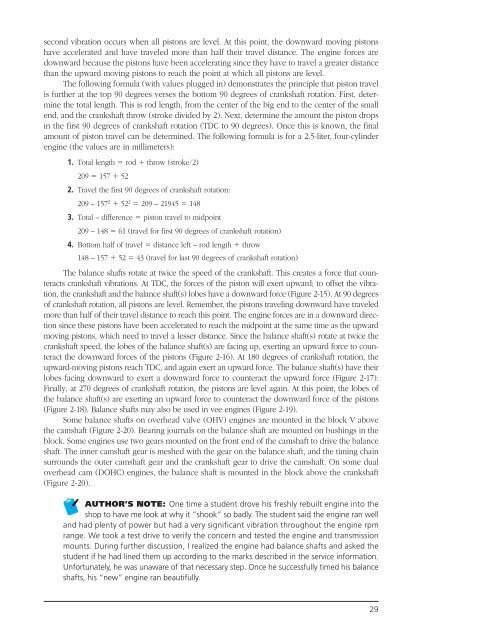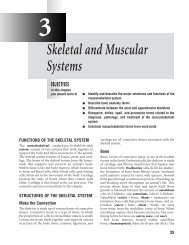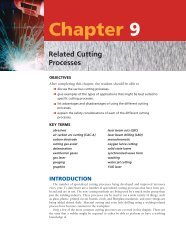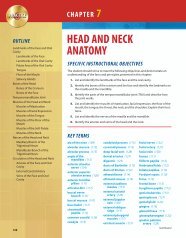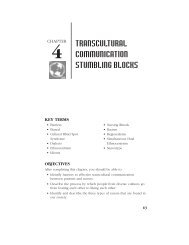Theory of Engine Operation - Delmar Learning
Theory of Engine Operation - Delmar Learning
Theory of Engine Operation - Delmar Learning
You also want an ePaper? Increase the reach of your titles
YUMPU automatically turns print PDFs into web optimized ePapers that Google loves.
second vibration occurs when all pistons are level. At this point, the downward moving pistons<br />
have accelerated and have traveled more than half their travel distance. The engine forces are<br />
downward because the pistons have been accelerating since they have to travel a greater distance<br />
than the upward moving pistons to reach the point at which all pistons are level.<br />
The following formula (with values plugged in) demonstrates the principle that piston travel<br />
is further at the top 90 degrees verses the bottom 90 degrees <strong>of</strong> crankshaft rotation. First, determine<br />
the total length. This is rod length, from the center <strong>of</strong> the big end to the center <strong>of</strong> the small<br />
end, and the crankshaft throw (stroke divided by 2). Next, determine the amount the piston drops<br />
in the first 90 degrees <strong>of</strong> crankshaft rotation (TDC to 90 degrees). Once this is known, the final<br />
amount <strong>of</strong> piston travel can be determined. The following formula is for a 2.5-liter, four-cylinder<br />
engine (the values are in millimeters):<br />
1. Total length 5 rod 1 throw (stroke/2)<br />
209 5 157 1 52<br />
2. Travel the first 90 degrees <strong>of</strong> crankshaft rotation:<br />
209 – 1572 1 522 5 209 – 21945 5 148<br />
3. Total – difference 5 piston travel to midpoint<br />
209 – 148 5 61 (travel for first 90 degrees <strong>of</strong> crankshaft rotation)<br />
4. Bottom half <strong>of</strong> travel 5 distance left – rod length 1 throw<br />
148 – 157 1 52 5 43 (travel for last 90 degrees <strong>of</strong> crankshaft rotation)<br />
The balance shafts rotate at twice the speed <strong>of</strong> the crankshaft. This creates a force that counteracts<br />
crankshaft vibrations. At TDC, the forces <strong>of</strong> the piston will exert upward; to <strong>of</strong>fset the vibration,<br />
the crankshaft and the balance shaft(s) lobes have a downward force (Figure 2-15). At 90 degrees<br />
<strong>of</strong> crankshaft rotation, all pistons are level. Remember, the pistons traveling downward have traveled<br />
more than half <strong>of</strong> their travel distance to reach this point. The engine forces are in a downward direction<br />
since these pistons have been accelerated to reach the midpoint at the same time as the upward<br />
moving pistons, which need to travel a lesser distance. Since the balance shaft(s) rotate at twice the<br />
crankshaft speed, the lobes <strong>of</strong> the balance shaft(s) are facing up, exerting an upward force to counteract<br />
the downward forces <strong>of</strong> the pistons (Figure 2-16). At 180 degrees <strong>of</strong> crankshaft rotation, the<br />
upward-moving pistons reach TDC, and again exert an upward force. The balance shaft(s) have their<br />
lobes facing downward to exert a downward force to counteract the upward force (Figure 2-17).<br />
Finally, at 270 degrees <strong>of</strong> crankshaft rotation, the pistons are level again. At this point, the lobes <strong>of</strong><br />
the balance shaft(s) are exerting an upward force to counteract the downward force <strong>of</strong> the pistons<br />
(Figure 2-18). Balance shafts may also be used in vee engines (Figure 2-19).<br />
Some balance shafts on overhead valve (OHV) engines are mounted in the block V above<br />
the camshaft (Figure 2-20). Bearing journals on the balance shaft are mounted on bushings in the<br />
block. Some engines use two gears mounted on the front end <strong>of</strong> the camshaft to drive the balance<br />
shaft. The inner camshaft gear is meshed with the gear on the balance shaft, and the timing chain<br />
surrounds the outer camshaft gear and the crankshaft gear to drive the camshaft. On some dual<br />
overhead cam (DOHC) engines, the balance shaft is mounted in the block above the crankshaft<br />
(Figure 2-20).<br />
AUTHOR’S NOTE: One time a student drove his freshly rebuilt engine into the<br />
shop to have me look at why it “shook” so badly. The student said the engine ran well<br />
and had plenty <strong>of</strong> power but had a very significant vibration throughout the engine rpm<br />
range. We took a test drive to verify the concern and tested the engine and transmission<br />
mounts. During further discussion, I realized the engine had balance shafts and asked the<br />
student if he had lined them up according to the marks described in the service information.<br />
Unfortunately, he was unaware <strong>of</strong> that necessary step. Once he successfully timed his balance<br />
shafts, his “new” engine ran beautifully.<br />
29


